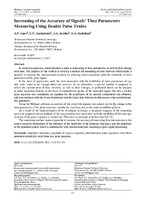Increasing of the Accuracy of Signalsʼ Time Parameters Measuring Using Double Pulse Trains

Date
2021Publisher
Another Title
Увеличение точности измерения временных параметров сигналов с использованием двойных импульсных последовательностей
Bibliographic entry
Increasing of the Accuracy of Signalsʼ Time Parameters Measuring Using Double Pulse Trains = Увеличение точности измерения временных параметров сигналов с использованием двойных импульсных последовательностей / A. V. Isaev [et al.] // Приборы и методы измерений. – 2021. – Т. 12, № 4. – С. 323-331.
Abstract
In modern diagnostics, much attention is paid to measuring of time parameters, as well as their change over time. The purpose of this work is to develop a method for measuring of time intervals which made it possible to increase the measurement accuracy by reducing errors associated with the instability of main parameters of the pulse signal. In the most of approaches used, the error associated with the instability of main parameters of signals under study is not enough taken into account. As an alternative, a spectral method is proposed in which the measurement of time intervals, as well as their changes, is performed based on the analysis of pulse sequences formed on the basis of characteristic points of the measured signal. For this a double pulse sequence was considered, an equation for the amplitudes of its spectral components was obtained, and in accordance with this it was determined that the delay time between double pulses is the most informative parameter. Using the Mathcad software, an analysis of the sensitivity regions was carried out for the change in the main parameters of the pulse sequence, namely the repetition rate, as the main destabilizing factor. As a result of the implementation of the developed technique, a structural diagram of the measuring system is proposed and an analysis of the measurement error associated with the instability of the main parameters of the pulse sequence is carried out. This error is estimated to be less than 0.01 %. The considered method makes it possible to increase the accuracy of measuring time intervals due to the almost complete elimination of the influence of the instability of the reference frequency and the amplitude of the generated pulses which is unattainable with modern hardware, including digital signal processing.
Abstract in another language
Измерению временных параметров, в том числе и их изменению, уделяется большое внимание в современной диагностике. Целью данной работы являлась разработка метода измерения временных интервалов, позволившего увеличить точность измерения за счёт уменьшения погрешностей, связанных с нестабильностью основных параметров импульсного сигнала. В большинстве используемых подходов, мало учитывается погрешность, связанная с нестабильностью основных параметров исследуемых сигналов. В качестве альтернативы предложен спектральный метод, при котором измерение временных интервалов, а также их изменения производится на основе анализа импульсных последовательностей, сформированных на основе характерных точек измеряемого сигнала. Для этого рассмотрена двойная импульсная последовательность, получено уравнение для амплитуд её спектральных составляющих и, в соответствии с этим, установлено, что время задержки между двойными импульсами является наиболее информативным параметром. Далее с помощью ПО Mathcad проведён анализ областей чувствительности на изменение основных параметров импульсной последовательности, а именно частоты следования, как основного дестабилизирующего фактора. Как результат реализации разработанной методики, предложена структурная схема измерительной системы и проанализирована погрешность измерения, связанная с нестабильностью основных параметров импульсной последовательности. Данная погрешность составляет менее 0,01 %. Таким образом, рассмотренный метод позволяет повысить точность измерения временных интервалов за счёт практически полного исключения влияния нестабильности опорной частоты и амплитуды формируемых импульсов, что недостижимо современными аппаратными средствами в том числе и при цифровой обработке сигналов.
View/
Collections
- Т. 12, № 4[8]
